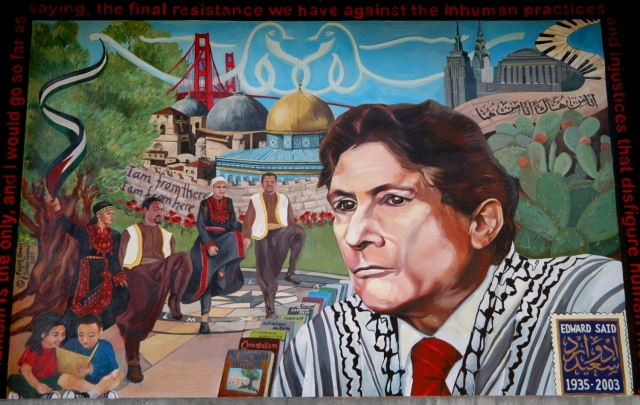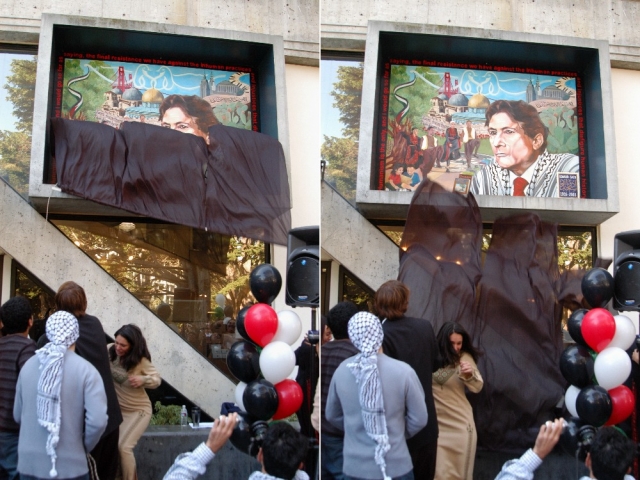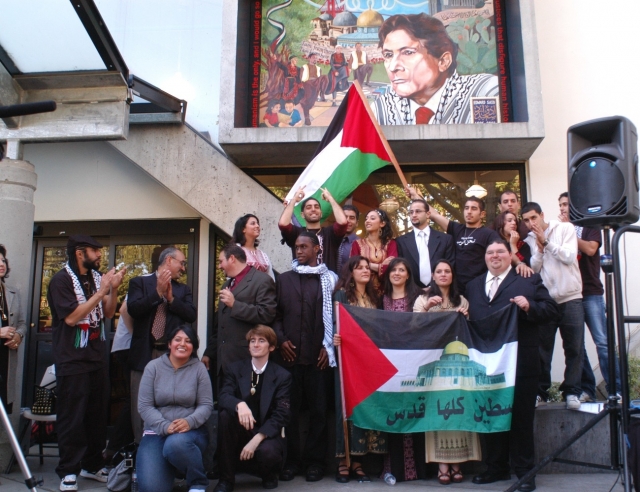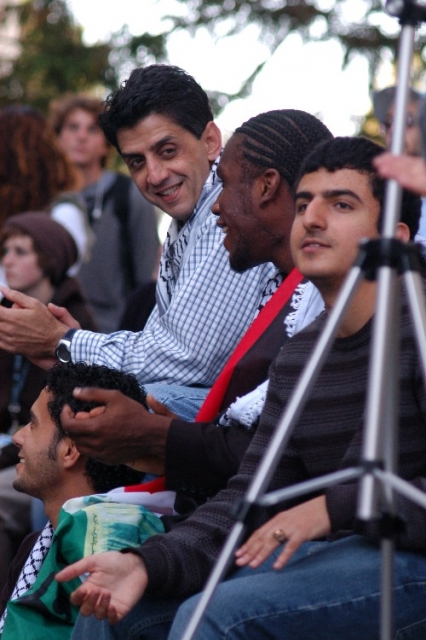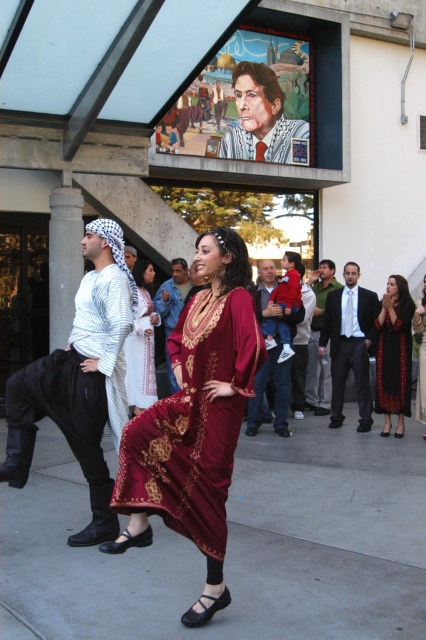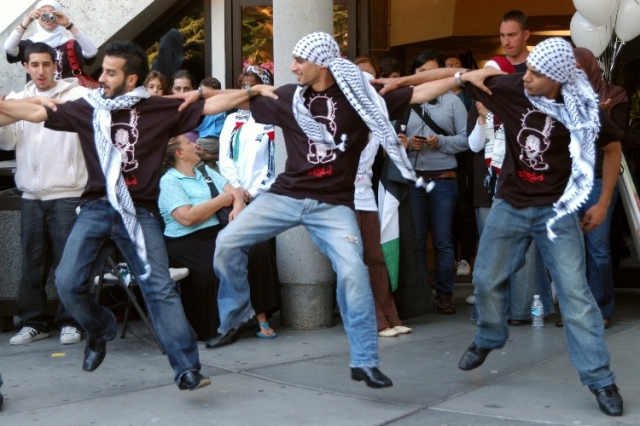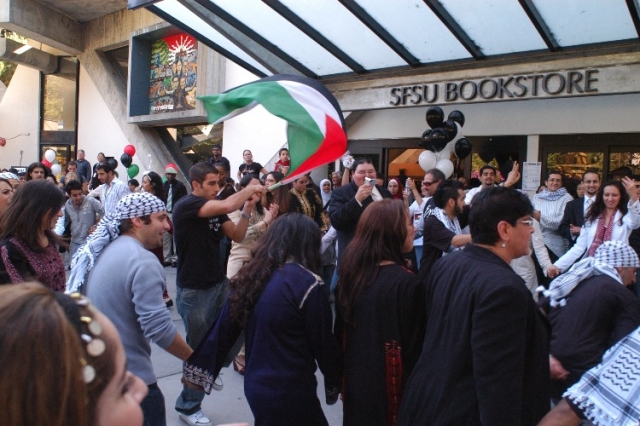From the Open-Publishing Calendar
From the Open-Publishing Newswire
Indybay Feature
Palestinian Cultural Mural Unveiled After Turbulent Struggle
A Palestinian Cultural Mural honoring Dr. Edward Sa'id was inaugurated on November 2, 2007 after a long political struggle by Palestinian students at San Francisco State University. The mural is an historic first of its kind in the United States.
Before an overflow audience as diverse as the San Francisco Bay Area community, the lead design artists, Dr. Fayeq Oweis and Dr. Susan Greene, a Palestinian and an American Jew, unveiled the Palestinian Cultural Mural at the César Chávez Student Center of San Francisco State University. The Palestinian Cultural Mural joins three others honoring César Chávez, Malcolm X, and the struggle of the Filipino people for true independence and justice.
The inauguration was part of a full day of celebrations that began in the morning with a community brunch, followed by a series of educational and commemorative talks, music, dance, and poetry. One keynote speech was given by Dr. Sonia Nimr, a historian and activist teaching at Birzeit University in the West Bank, Palestine, and co-author with Elizabeth Laird of the children's book A Little Piece of Ground. Dr. Hatem Bazian, who teaches at the University of California in Berkeley and is an alumnus of San Francisco State University, spoke of the present-day struggle of the Palestinian people against relentless occupation and oppression and the role of the U.S. political system in supporting that oppression while suppressing genuine public debate on the subject.
But the heart of the inauguration was left to a student from the organization that spearheaded the arduous effort of turning the Palestinian Cultural Mural into a reality. Loubna Qutami, representing the General Union of Palestinian Students (GUPS), spoke about her organization, its goals, and the purpose and meaning of the Mural.
GUPS was officially launched in 1959 by Palestinian students studying in Cairo, Egypt. In the following decades, over a hundred branches of GUPS were formed worldwide by the Palestinian diaspora. The GUPS chapter at San Francisco State University dates back to the 1970s. GUPS has played a crucial role worldwide in increasing awareness of the Palestinian struggle for justice and equality. It supports an immediate end to the occupation of Palestinian land and condemns U.S. financial support of that Israeli occupation.
The inspiration for a Palestinian Cultural Mural began as an idea to honor and celebrate Palestinian identity, culture, and thought in an academic setting. With the death of Dr. Edward W. Sa'id in 2003 and the publication of his most recent book, Culture and Resistance, consisting of David Barsamian's conversations with Sa'id, it seemed only to fitting to dedicate a cultural mural to Dr. Sa'id.
Sa'id served as Professor of English and Comparative Literature at Columbia University for four decades. He attained the rank of University Professor in 1992, Columbia's most prestigious academic title. He served for two decades as a member of the Palestine National Council (PNC), resigning in 1991 because of his advocacy of "co-existence between Israeli Jews and Palestinian Arabs." Sa'id ultimately came to reject Yasser Arafat's vacillation and often self-serving moves at the Oslo accords that failed to bring freedom and justice to the Palestinian people. In 2002, Sa'id joined the Palestinian National Initiative, led by Dr. Mustafa Barghouti, as a democratic alternative to Fatah and Islamist militant groups like Hamas. It has called for "establishment of a sovereign, independent, viable, and democratic Palestinian state on all of the territories occupied by Israel in 1967."
Sa'id was a humanist. In response to David Barsamian's question on how suffering can be measured or compared, Dr. Sa'id said: "It's scandalous and offensive to compare suffering. To say that 'what they are doing to the Palestinians is what they did to the Jews" is not true at all. What the Jews went through is horrendous, and really without precedent. But on the other hand, that can't be used as a way of diminishing the terrible punishment that Palestinians have suffered at the hands of Israelis. It's not a matter of comparison. It's a matter of saying that both are unacceptable."
In 2004, the Palestinian Cultural Mural Committee, composed of students, faculty, staff, and administrators from a wide array of ethnic and religious backgrounds, was established to follow the established university process for seeking approvals for the Mural. This included more than a year of public comments and two town hall meetings to discuss the elements to be included in the mural artwork. These public hearings resulted in over two hundred responses which were considered in further open meetings to finalize the design. Then the Associated Students of San Francisco State University (SFSU) gave its overwhelming approval of the planned Mural.
However, the effort to create a Palestinian Cultural Mural did not come without opposition. The Israel lobby and its supporters sought to pressure the University to block the proposed mural. SFSU President Robert A Corrigan immediately rejected the mural, claiming that it represents a "culture of violence" and that he “won’t allow hatred towards Jews on these walls.” Yet he could cite no specific evidence to support such claims, only objecting to the proposed Mural's depiction of Handala and a Palestinian house key with "العودة" ("the Return") written in Arabic. Handala (حنظلة) is a popular cultural icon created by the late Palestinian cartoonist, Naji Salim al-Ali, depicting a poor barefoot Palestinian boy who represents a unified identity for Palestinians wherever they live.
A firestorm of protest from students, faculty, and the community in 2005 forced a compromise that dropped Handala and al-Awda from the Mural, but enabled the project to move forward to implementation. The final Mural, nevertheless, includes the first verse of Mahmoud Darwish's farewell poem dedicated to Dr. Sa'id in 2003, "أنا من هناك, أنا من هنا" ("I am from there, I am from here"), tacitly recognizing the displacement and dilemma of the Palestinian diaspora.
After another two years of planning, organizing, drawing, and painting, on Friday, November 2nd, 2007, a day-long celebration was held to inaugurate the Palestinian Cultural Mural.
So how does a "cultural mural" recognize the Palestinian struggle rather than a more explicitly political mural like others in the César Chávez Student Center? As Dr. Edward Sa'id had put it, "Culture is a way of fighting against extinction and obliteration."
The inauguration was part of a full day of celebrations that began in the morning with a community brunch, followed by a series of educational and commemorative talks, music, dance, and poetry. One keynote speech was given by Dr. Sonia Nimr, a historian and activist teaching at Birzeit University in the West Bank, Palestine, and co-author with Elizabeth Laird of the children's book A Little Piece of Ground. Dr. Hatem Bazian, who teaches at the University of California in Berkeley and is an alumnus of San Francisco State University, spoke of the present-day struggle of the Palestinian people against relentless occupation and oppression and the role of the U.S. political system in supporting that oppression while suppressing genuine public debate on the subject.
But the heart of the inauguration was left to a student from the organization that spearheaded the arduous effort of turning the Palestinian Cultural Mural into a reality. Loubna Qutami, representing the General Union of Palestinian Students (GUPS), spoke about her organization, its goals, and the purpose and meaning of the Mural.
GUPS was officially launched in 1959 by Palestinian students studying in Cairo, Egypt. In the following decades, over a hundred branches of GUPS were formed worldwide by the Palestinian diaspora. The GUPS chapter at San Francisco State University dates back to the 1970s. GUPS has played a crucial role worldwide in increasing awareness of the Palestinian struggle for justice and equality. It supports an immediate end to the occupation of Palestinian land and condemns U.S. financial support of that Israeli occupation.
The inspiration for a Palestinian Cultural Mural began as an idea to honor and celebrate Palestinian identity, culture, and thought in an academic setting. With the death of Dr. Edward W. Sa'id in 2003 and the publication of his most recent book, Culture and Resistance, consisting of David Barsamian's conversations with Sa'id, it seemed only to fitting to dedicate a cultural mural to Dr. Sa'id.
Sa'id served as Professor of English and Comparative Literature at Columbia University for four decades. He attained the rank of University Professor in 1992, Columbia's most prestigious academic title. He served for two decades as a member of the Palestine National Council (PNC), resigning in 1991 because of his advocacy of "co-existence between Israeli Jews and Palestinian Arabs." Sa'id ultimately came to reject Yasser Arafat's vacillation and often self-serving moves at the Oslo accords that failed to bring freedom and justice to the Palestinian people. In 2002, Sa'id joined the Palestinian National Initiative, led by Dr. Mustafa Barghouti, as a democratic alternative to Fatah and Islamist militant groups like Hamas. It has called for "establishment of a sovereign, independent, viable, and democratic Palestinian state on all of the territories occupied by Israel in 1967."
Sa'id was a humanist. In response to David Barsamian's question on how suffering can be measured or compared, Dr. Sa'id said: "It's scandalous and offensive to compare suffering. To say that 'what they are doing to the Palestinians is what they did to the Jews" is not true at all. What the Jews went through is horrendous, and really without precedent. But on the other hand, that can't be used as a way of diminishing the terrible punishment that Palestinians have suffered at the hands of Israelis. It's not a matter of comparison. It's a matter of saying that both are unacceptable."
In 2004, the Palestinian Cultural Mural Committee, composed of students, faculty, staff, and administrators from a wide array of ethnic and religious backgrounds, was established to follow the established university process for seeking approvals for the Mural. This included more than a year of public comments and two town hall meetings to discuss the elements to be included in the mural artwork. These public hearings resulted in over two hundred responses which were considered in further open meetings to finalize the design. Then the Associated Students of San Francisco State University (SFSU) gave its overwhelming approval of the planned Mural.
However, the effort to create a Palestinian Cultural Mural did not come without opposition. The Israel lobby and its supporters sought to pressure the University to block the proposed mural. SFSU President Robert A Corrigan immediately rejected the mural, claiming that it represents a "culture of violence" and that he “won’t allow hatred towards Jews on these walls.” Yet he could cite no specific evidence to support such claims, only objecting to the proposed Mural's depiction of Handala and a Palestinian house key with "العودة" ("the Return") written in Arabic. Handala (حنظلة) is a popular cultural icon created by the late Palestinian cartoonist, Naji Salim al-Ali, depicting a poor barefoot Palestinian boy who represents a unified identity for Palestinians wherever they live.
A firestorm of protest from students, faculty, and the community in 2005 forced a compromise that dropped Handala and al-Awda from the Mural, but enabled the project to move forward to implementation. The final Mural, nevertheless, includes the first verse of Mahmoud Darwish's farewell poem dedicated to Dr. Sa'id in 2003, "أنا من هناك, أنا من هنا" ("I am from there, I am from here"), tacitly recognizing the displacement and dilemma of the Palestinian diaspora.
After another two years of planning, organizing, drawing, and painting, on Friday, November 2nd, 2007, a day-long celebration was held to inaugurate the Palestinian Cultural Mural.
So how does a "cultural mural" recognize the Palestinian struggle rather than a more explicitly political mural like others in the César Chávez Student Center? As Dr. Edward Sa'id had put it, "Culture is a way of fighting against extinction and obliteration."
For more information:
http://userwww.sfsu.edu/~gups/
Add Your Comments
Comments
(Hide Comments)
It is a wonderful and positive step that the offending elements were eliminated from this mural and that it finally went through. Teh spirit of compromise is alive at SFSU
I attended the unveiling of this wonderful piece and was so moved by the ceremony and the inspiring words of all who spoke, and of course the beautiful mural. What a wonderful tribute to one of the great heroes of the world as well as all the heroes and heroines struggling for justice and peace for Palestine. And to think it almost didn't happen. Palestinian students of SFSU and their supporters, endless thanks to you all!
We are 100% volunteer and depend on your participation to sustain our efforts!
Get Involved
If you'd like to help with maintaining or developing the website, contact us.
Publish
Publish your stories and upcoming events on Indybay.
Topics
More
Search Indybay's Archives
Advanced Search
►
▼
IMC Network


